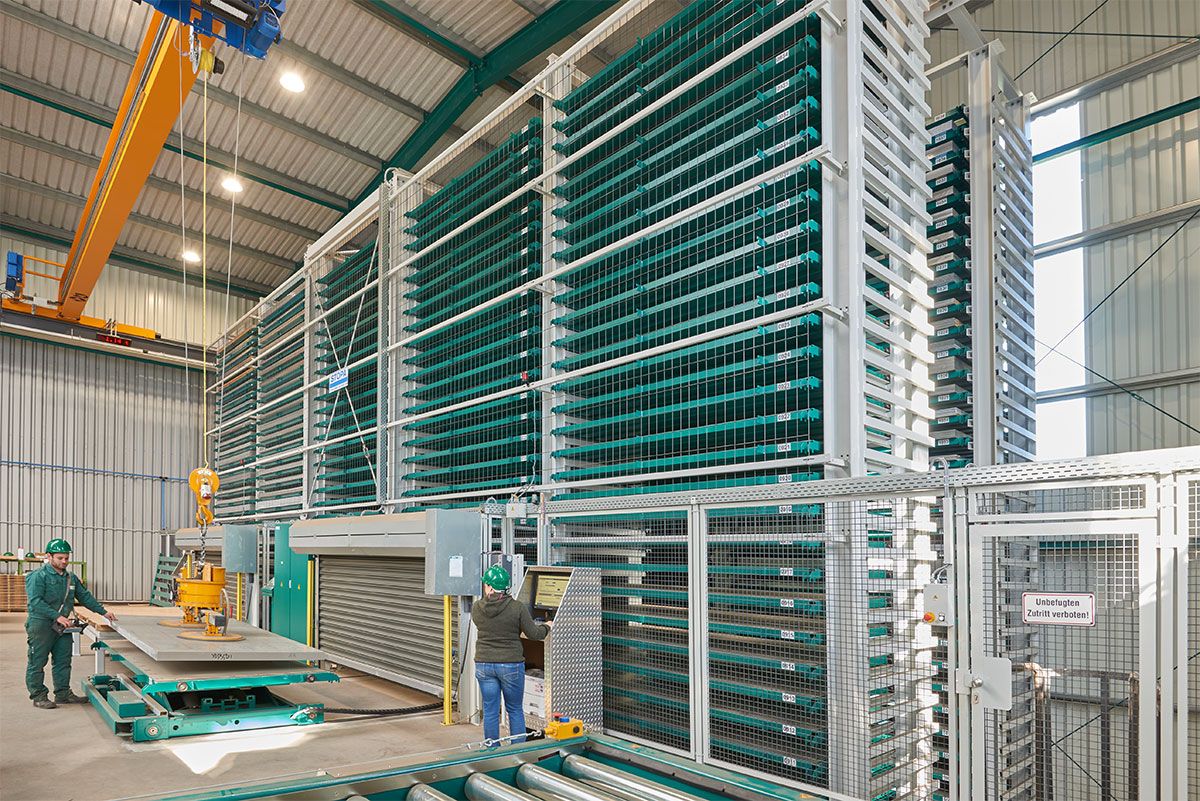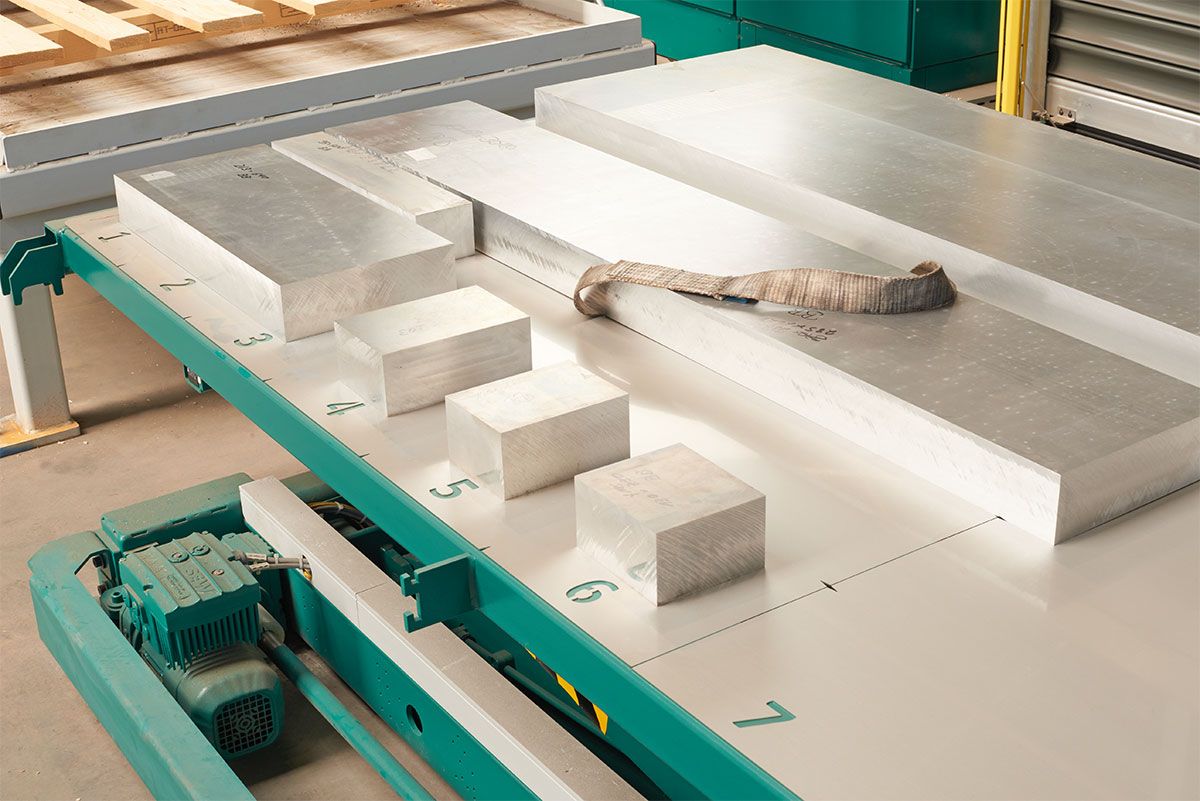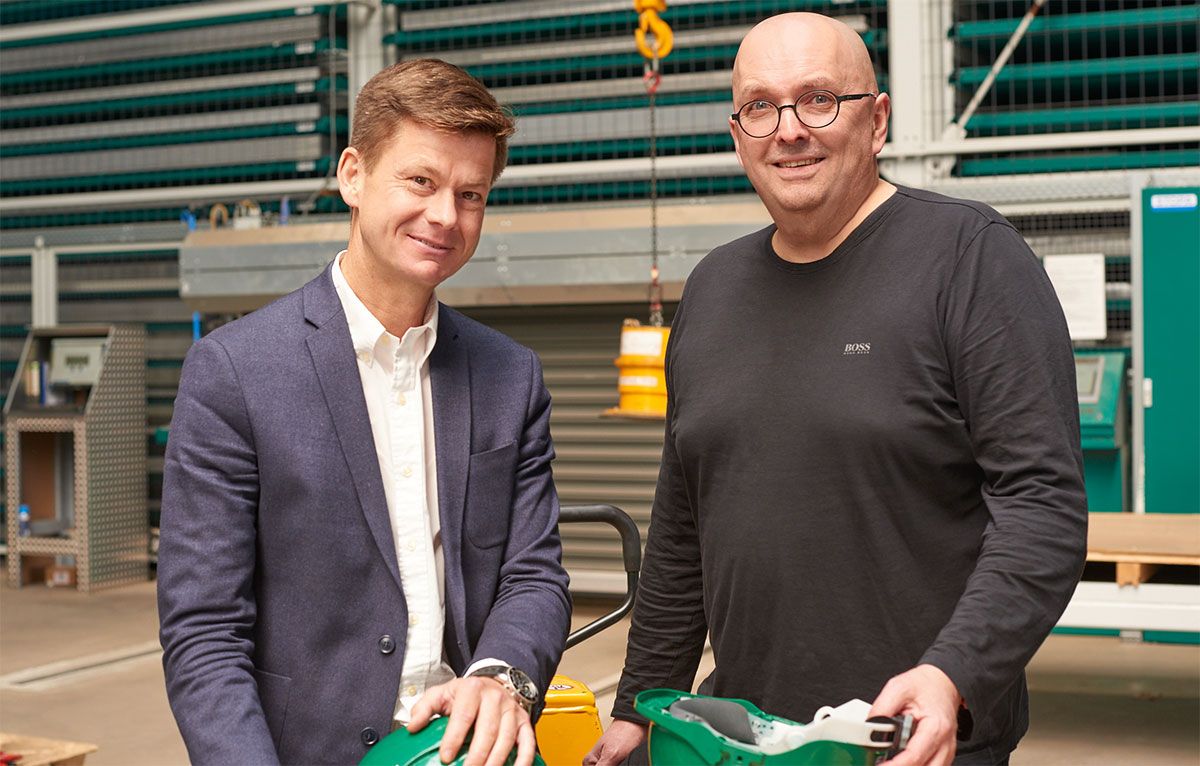WMS 4.0 supports economical use of materials
By investing in a STOPA COMPACT II sheet metal storage system for aluminum sheets, the steel wholesaler Eisen Schmitt has significantly accelerated production processes at its St. Ingbert plant, thus optimizing its processes. The automated storage system is equipped with the STOPA WMS 4.0, which communicates with the higher-level ERP system and the sawing machines to be supplied.
Alois Schmitt GmbH & Co. KG (Eisen Schmitt), which was founded in 1930 at its headquarters in Karlsruhe, stocks and processes aluminum sheets in St. Ingbert. Its range of more than 15,000 items includes a wide variety of steels, as well as pipes, non-ferrous metals and plastics. The basis for space-saving, economical storage is the automatic STOPA COMPACT II sheet metal storage system, which has over 369 storage locations.
To ensure efficient communication between the STOPA WMS 4.0 warehouse management software, the operator’s ERP system and the sawing system’s waste optimization software (VOS), STOPA Anlagenbau GmbH, Achern-Gamshurst, a company that offers a wide range of customized solutions, has developed interfaces. Thomas Vilsmeier, a graduate in business administration and a member of the management team at Eisen Schmitt, unfolds a drawing to illustrate the processes involved in optimizing waste. “Because the data from the transport orders generated by the WMS is automatically transferred to the saws via the interfaces, manual entries are no longer necessary and the error rate is reduced.”
Shorter throughput times

The STOPA WMS 4.0 of the automatic warehouse communicates with the higher-level ERP system and with the sawing machines to be supplied
Deliveries are recorded in the goods-in department and booked in the ERP system, which forwards the information to the STOPA WMS 4.0. The WMS, which manages floor spaces in addition to the sheet metal storage, generates the storage orders and provides empty pallets using its search function. The warehouse operator loads the raw material onto the load carrier selected by the WMS at the incoming goods station. This is done exactly according to the coordinates specified by the software, into which the pallet is divided. Then he releases the load carrier for storage. The WMS transfers the data of the transport order to the stock and posts it to the relevant pallet. If the capacity of one of the pallets, which has a maximum usable area of 1,550 x 3,050 millimeters, is not sufficient to hold the quantity to be stored, the employee requests further empty pallets and posts the partial quantities manually.
Customer orders are assigned to one of the saws, which cut the parts in a size range from about 40 x 20 to 3,000 x 1,500 millimeters. The WMS transfers the information received from the ERP system to the data format of the VOS and writes it to its input directory. In addition, this file contains a list of all stocks with their materials.
Tapio Sutter, branch manager at Eisen Schmitt in St. Ingbert, stops at a sawing machine during his tour. “One of the primary goals of our investments was to achieve shorter production cycles. Thanks to the smooth communication between the systems, we have been able to significantly optimize our processes.”
Before nesting, the VOS distributes the orders to the stock of the approximately 22-meter-long, 11-meter-high and 5.7-meter-wide STOPA COMPACT II. The software ensures that the nesting is tight and thus saves material. The WMS specifies the required number of pallets to be retrieved, depending on the quantity of the ordered blanks. Load carriers with residual sheets have a higher priority in order to reduce their stocks. While the WMS initiates the retrieval orders, the VOS transmits the cutting data to the selected saw. The operator removes the material from the scissor lift table using an overhead crane. Since there are usually several pieces of scrap material on a pallet, he identifies the sheet to be removed by means of a barcode label that is affixed after each cut. In addition to information on the material and dimensions, the label contains the batch number and a plain text.
The leftover sheets that arise at the sawing machines, which are all rectangular, are stored back by Eisen Schmitt. VOS uses the number and sizes of these to create files that the WMS reports to the ERP system and uses to create storage orders. If the remnants have to be stacked on a pallet before storage, which is possible up to a maximum loading height of 165 millimeters, the employee selects the load carrier from a list of suggestions generated by the WMS. In doing so, he ensures that the materials are stored separately to avoid mixing different materials. Sutter points to the coordinates of a pallet. “By deciding to divide the pallets into fields, the WMS knows where the individual blanks are located on the load carriers.”
Highlights of the solution
- Shorter production cycles
- Significant process optimization
- High process reliability
- Minimized error rates
- Optimal communication channels
- Economical storage

By deciding to divide the pallets into fields, the WMS is informed of the locations of individual blanks on the load carriers
Space gained by pit
The STOPA COMPACT II, which is controlled by a real-time soft PLC, started operation in March 2018. The sheet metal warehouse operates around the clock with a handling capacity of approximately 450 tons per year. The company, which supplies customers in Germany and neighboring countries as a wholesaler with a good 200 employees, previously relied on shelves and forklifts. Vilsmeier looks up and down the hall. “If STOPA had not offered to build the warehouse in a three-meter-deep pit to expand the available space in the factory building, we would have had to build the building higher.”
At Eisen Schmitt, the automated warehouse is equipped with two scissor lift tables. One of them is used purely for outgoing goods, while the other is used as a goods-in and goods-out station. The manufacturer has equipped this with a pneumatic carriage lock, a pallet lock and with pluggable stops for a coordinate corner, so that the aluminum sheets delivered can be precisely positioned and secured against movement.
Thanks to the more compact design of its double-mast storage and retrieval system (SRM), the STOPA COMPACT II has two more storage locations per rack block than its predecessor. Since the system at Eisen Schmitt consists of ten blocks arranged in two rows, the full-range supplier benefits from 20 additional locations and thus from significantly more storage capacity. In addition, the RBG ensures a high level of safety because it automatically checks the storage locations above and below the selected storage locations for their load and thus prevents collisions.
The advantages of the solution also include the individually adjustable acceleration values of the RBG, which prevent the material from slipping, as well as intelligent energy management. This is based on the use of two lightweight drive motors instead of one heavy one, which reduces the overall weight. In addition, an intermediate circuit coupling is used to utilize the regenerative braking energy of a drive by making it available to another drive as motor energy.
Investment targets achieved

Dipl.-Business Economist Thomas Vilsmeier member of the management team at Eisen Schmitt (left), and Tapio Sutter, branch manager at Eisen Schmitt in St. Ingbert (right)
Vilsmeier is relaxed as he looks at the storage-related processes. “The storage concept we chose offers high performance and process reliability. We also chose STOPA because the company is known as a premium manufacturer of sheet metal storage systems. We received confirmation of this when we visited reference systems.” Sutter nods in agreement. ”Our investment goals have been achieved. We needed minimized error rates during storage and retrieval, as well as shorter and more secure production processes. In addition, we benefit from a more economical material yield, as less waste is produced.”
The price-performance ratio and the combination of STOPA and TRUMPF as suppliers, which excludes interface problems due to many years of experience, also contributed to the decision to invest in STOPA. The fact that all deadlines were met was due not least to the parallel planning of the building and the warehouse. The STOPA COMPACT II, which operates in two shifts with almost 100 percent availability, was launched in December 2018. Johann Bürger is already thinking ahead. “Since the sheet metal storage system can be expanded at any time in a future-oriented manner, we are relying on the option of being able to integrate a third station on the upper floor of the hall and connect additional machines.”
Author: Jürgen Warmbol
Sales Contact Person

Holger Dehmelt
Sales Engineer Warehouse Technology
STOPA Anlagenbau GmbH
Industriestr. 12
77855 Achern-Gamshurst

Rolf Eckhardt
Sales Engineer Warehouse Technology
STOPA Anlagenbau GmbH
Industriestr. 12
77855 Achern-Gamshurst

Andreas Pahl
Sales Engineer Warehouse Technology
STOPA Anlagenbau GmbH
Industriestr. 12
77855 Achern-Gamshurst